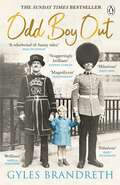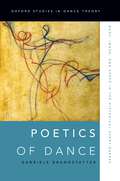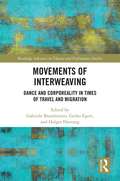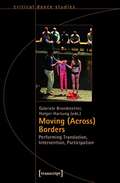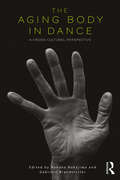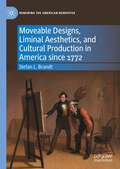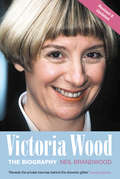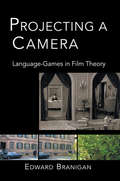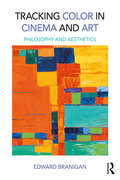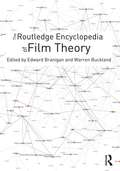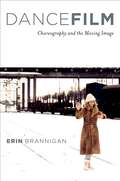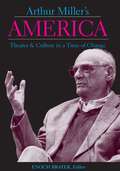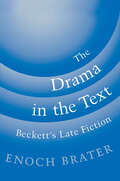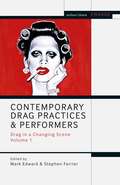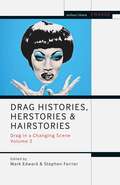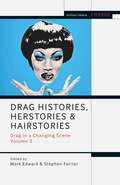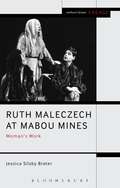- Table View
- List View
Odd Boy Out: The ‘hilarious, eye-popping, unforgettable’ Sunday Times bestseller 2021
by Gyles BrandrethJoin the beloved star of Just a Minute, QI, Have I Got News For You and Celebrity Gogglebox, Gyles Brandreth, in his long-waited, moving and hilarious autobiography'Staggeringly brilliant, funny and touching, I loved it' Joanna Lumley'Hilarious, ribald, eye-popping, unforgettable, will make you laugh out loud' Daily Mail_________'I am what my childhood made me'But what is that exactly, Gyles?Who are you? And why?Odd Boy Out is an extraordinarily revealing account of growing up in an apparently well-to-do but always strapped-for-cash middle-class English family. But it is also far more than that.It is about adventures - meeting princes and presidents, visiting Death Row in America, exploring the sex clubs of Copenhagen. It is a story of a boy blessed with wit, what he got up to, and the people he met growing up in the most wonderful city in all the world in those extraordinary years after the Second World War.For Odd Boy Out is about more than Gyles and his exploits: it is also a kaleidoscopic portrait of Britain from the 1950s onwards, featuring a cast drawn from politics, the media, swinging London, stage and screen, from Laurence Olivier to Twiggy.By turns hilarious and moving, and chock full of unforgettable stories, Odd Boy Out is the unexpected and candid autobiography of one of the country's most unlikely personalities.Yet at root it is a powerful and passionate exploration of childhood - how our heritage, our parents and our upbringing make us who we are.
Poetics of Dance: Body, Image, and Space in the Historical Avant-Gardes (Oxford Studies in Dance Theory)
by Gabriele BrandstetterWhen it was first published in Germany in 1995, Poetics of Dance was already seen as a path-breaking publication, the first to explore the relationships between the birth of modern dance, new developments in the visual arts, and the renewal of literature and drama in the form of avant-garde theatrical and movement productions of the early twentieth-century. Author Gabriele Brandstetter established in this book not only a relation between dance and critical theory, but in fact a full interdisciplinary methodology that quickly found foothold with other areas of research within dance studies. The book looks at dance at the beginnings of the 20th century, the time during which modern dance first began to make its radical departure from the aesthetics of classical ballet. Brandstetter traces modern dance's connection to new innovations and trends in visual and literary arts to argue that modern dance is in fact the preeminent symbol of modernity. As Brandstetter demonstrates, the aesthetic renewal of dance vocabulary which was pursued by modern dancers on both sides of the Atlantic - Isadora Duncan and Loie Fuller, Valeska Gert and Oskar Schlemmer, Vaslav Nijinsky and Michel Fokine - unfurled itself in new ideas about gender and subjectivity in the arts more generally, thus reflecting the modern experience of life and the self-understanding of the individual as an individual. As a whole, the book makes an important contribution to the theory of modernity.
Poetics of Dance: Body, Image, and Space in the Historical Avant-Gardes (Oxford Studies in Dance Theory)
by Gabriele BrandstetterWhen it was first published in Germany in 1995, Poetics of Dance was already seen as a path-breaking publication, the first to explore the relationships between the birth of modern dance, new developments in the visual arts, and the renewal of literature and drama in the form of avant-garde theatrical and movement productions of the early twentieth-century. Author Gabriele Brandstetter established in this book not only a relation between dance and critical theory, but in fact a full interdisciplinary methodology that quickly found foothold with other areas of research within dance studies. The book looks at dance at the beginnings of the 20th century, the time during which modern dance first began to make its radical departure from the aesthetics of classical ballet. Brandstetter traces modern dance's connection to new innovations and trends in visual and literary arts to argue that modern dance is in fact the preeminent symbol of modernity. As Brandstetter demonstrates, the aesthetic renewal of dance vocabulary which was pursued by modern dancers on both sides of the Atlantic - Isadora Duncan and Loie Fuller, Valeska Gert and Oskar Schlemmer, Vaslav Nijinsky and Michel Fokine - unfurled itself in new ideas about gender and subjectivity in the arts more generally, thus reflecting the modern experience of life and the self-understanding of the individual as an individual. As a whole, the book makes an important contribution to the theory of modernity.
Movements of Interweaving: Dance and Corporeality in Times of Travel and Migration (Routledge Advances in Theatre & Performance Studies)
by Gabriele Brandstetter Gerko Egert Holger HartungMovements of Interweaving is a rich collection of essays exploring the concept of interweaving performance cultures in the realms of movement, dance, and corporeality. Focusing on dance performances as well as on scenarios of cultural movements on a global scale, it not only challenges the concept of intercultural dance performances, but through its innovative approach also calls attention to the specific qualities of "interweaving" as a form of movement itself. Divided into four sections, this volume features an international team of scholars together developing a new critical perspective on the cultural practices of movement, travel and migration in and beyond dance.
Movements of Interweaving: Dance and Corporeality in Times of Travel and Migration (Routledge Advances in Theatre & Performance Studies)
by Gabriele Brandstetter Gerko Egert Holger HartungMovements of Interweaving is a rich collection of essays exploring the concept of interweaving performance cultures in the realms of movement, dance, and corporeality. Focusing on dance performances as well as on scenarios of cultural movements on a global scale, it not only challenges the concept of intercultural dance performances, but through its innovative approach also calls attention to the specific qualities of "interweaving" as a form of movement itself. Divided into four sections, this volume features an international team of scholars together developing a new critical perspective on the cultural practices of movement, travel and migration in and beyond dance.
Moving: Performing Translation, Intervention, Participation (TanzScripte #40)
by Gabriele Brandstetter Holger HartungAs performative and political acts, translation, intervention, and participation are movements that take place across, along, and between borders. Such movements traverse geographic boundaries, affect social distinctions, and challenge conceptual categorizations - while shifting and transforming lines of separation themselves. This book brings together choreographers, movement practitioners, and theorists from various fields and disciplines to reflect upon such dynamics of difference. From their individual cultural backgrounds, they ask how these movements affect related fields such as corporeality, perception, (self-)representation, and expression.
The Aging Body in Dance: A cross-cultural perspective
by Gabriele Brandstetter Nanako NakajimaWhat does it mean to be able to move? The Aging Body in Dance brings together leading scholars and artists from a range of backgrounds to investigate cultural ideas of movement and beauty, expressiveness and agility. Contributors focus on Euro-American and Japanese attitudes towards aging and performance, including studies of choreographers, dancers and directors from Yvonne Rainer, Martha Graham, Anna Halprin and Roemeo Castellucci to Kazuo Ohno and Kikuo Tomoeda. They draw a fascinating comparison between youth-oriented Western cultures and dance cultures like Japan’s, where aging performers are celebrated as part of the country’s living heritage. The first cross-cultural study of its kind, The Aging Body in Dance offers a vital resource for scholars and practitioners interested in global dance cultures and their differing responses to the world's aging population.
The Aging Body in Dance: A cross-cultural perspective
by Gabriele Brandstetter Nanako NakajimaWhat does it mean to be able to move? The Aging Body in Dance brings together leading scholars and artists from a range of backgrounds to investigate cultural ideas of movement and beauty, expressiveness and agility. Contributors focus on Euro-American and Japanese attitudes towards aging and performance, including studies of choreographers, dancers and directors from Yvonne Rainer, Martha Graham, Anna Halprin and Roemeo Castellucci to Kazuo Ohno and Kikuo Tomoeda. They draw a fascinating comparison between youth-oriented Western cultures and dance cultures like Japan’s, where aging performers are celebrated as part of the country’s living heritage. The first cross-cultural study of its kind, The Aging Body in Dance offers a vital resource for scholars and practitioners interested in global dance cultures and their differing responses to the world's aging population.
Moveable Designs, Liminal Aesthetics, and Cultural Production in America since 1772 (Renewing the American Narrative)
by Stefan L. BrandtThe book explores the liminal aesthetics of U.S. cultural and literary practice. Interrogating the notion of a presumptive unity of the American experience, Moveable Designs argues that inner conflict, divisiveness, and contradiction are integral to the nation’s cultural designs, themes, and motifs. The study suggests that U.S. literary and cultural practice is permeated by ‘moveable designs’—flexible, yet constant features of hegemonial practice that constitute an integral element of American national self-fashioning. The naturally pervasive liminality of U.S. cultural production is the key to understanding the resilience of American culture. Moveable Designs looks at artistic expressions across various media types (literature, paintings, film, television), seeking to illuminate critical phases of U.S. American literature and culture—from the revolutionary years to the movements of romanticism, realism, and modernism, up to the postmodern era. It combines a wide array of approaches, from cultural history and social anthropology to phenomenology. Connecting an analysis of literary and cultural texts with approaches from design theory, the book proposes a new way of understanding American culture as design. It is one of the unique characteristics of American culture that it creates—or, rather, designs—potency out of its inner conflicts and apparent disunities. That which we describe as an identifiable ‘American identity’ is actually the product of highly vulnerable, alternating processes of dissolution and self-affirmation.
Victoria Wood: The Biography
by Neil Brandwood'One of the great British comedians and all-round entertainers of her generation' Guardian'Bittersweet but scalpel sharp' Radio Times'One of Britain’s finest ever performers ... a sublime and unparalleled crafter of words' Independent Victoria Wood's wit and humour endeared her to millions of TV viewers for over four decades. Writer, producer and actress of television shows such as As Seen on TV and Dinnerladies, Victoria was often voted the funniest woman in Britain. Her rise to stardom, from her early years in Lancashire to the successes of the sell-out shows at the Royal Albert Hall, is sympathetically and honestly portrayed by Neil Brandwood. This meticulously researched and written biography provides an insightful account of the life and career of one of Britain's best-loved comediennes.
Projecting a Camera: Language-Games in Film Theory
by Edward BraniganIn Projecting a Camera, film theorist Edward Branigan offers a groundbreaking approach to understanding film theory. Why, for example, does a camera move? What does a camera "know"? (And when does it know it?) What is the camera's relation to the subject during long static shots? What happens when the screen is blank? Through a wide-ranging engagement with Wittgenstein and theorists of film, he offers one of the most fully developed understandings of the ways in which the camera operates in film. With its thorough grounding in the philosophy of spectatorship and narrative, Projecting a Camera takes the study of film to a new level. With the care and precision that he brought to Narrative Comprehension and Film, Edward Branigan maps the ways in which we must understand the role of the camera, the meaning of the frame, the role of the spectator, and other key components of film-viewing. By analyzing how we think, discuss, and marvel about the films we see, Projecting a Camera, offers insights rich in implications for our understanding of film and film studies.
Projecting a Camera: Language-Games in Film Theory
by Edward BraniganIn Projecting a Camera, film theorist Edward Branigan offers a groundbreaking approach to understanding film theory. Why, for example, does a camera move? What does a camera "know"? (And when does it know it?) What is the camera's relation to the subject during long static shots? What happens when the screen is blank? Through a wide-ranging engagement with Wittgenstein and theorists of film, he offers one of the most fully developed understandings of the ways in which the camera operates in film. With its thorough grounding in the philosophy of spectatorship and narrative, Projecting a Camera takes the study of film to a new level. With the care and precision that he brought to Narrative Comprehension and Film, Edward Branigan maps the ways in which we must understand the role of the camera, the meaning of the frame, the role of the spectator, and other key components of film-viewing. By analyzing how we think, discuss, and marvel about the films we see, Projecting a Camera, offers insights rich in implications for our understanding of film and film studies.
Tracking Color in Cinema and Art: Philosophy and Aesthetics
by Edward BraniganColor is one of cinema’s most alluring formal systems, building on a range of artistic traditions that orchestrate visual cues to tell stories, stage ideas, and elicit feelings. But what if color is not—or not only—a formal system, but instead a linguistic effect, emerging from the slipstream of our talk and embodiment in a world? This book develops a compelling framework from which to understand the mobility of color in art and mind, where color impressions are seen through, and even governed by, patterns of ordinary language use, schemata, memories, and narrative. Edward Branigan draws on the work of Ludwig Wittgenstein and other philosophers who struggle valiantly with problems of color aesthetics, contemporary theories of film and narrative, and art-historical models of analysis. Examples of a variety of media, from American pop art to contemporary European cinema, illustrate a theory based on a spectator’s present-time tracking of temporal patterns that are firmly entwined with language use and social intelligence.
Tracking Color in Cinema and Art: Philosophy and Aesthetics
by Edward BraniganColor is one of cinema’s most alluring formal systems, building on a range of artistic traditions that orchestrate visual cues to tell stories, stage ideas, and elicit feelings. But what if color is not—or not only—a formal system, but instead a linguistic effect, emerging from the slipstream of our talk and embodiment in a world? This book develops a compelling framework from which to understand the mobility of color in art and mind, where color impressions are seen through, and even governed by, patterns of ordinary language use, schemata, memories, and narrative. Edward Branigan draws on the work of Ludwig Wittgenstein and other philosophers who struggle valiantly with problems of color aesthetics, contemporary theories of film and narrative, and art-historical models of analysis. Examples of a variety of media, from American pop art to contemporary European cinema, illustrate a theory based on a spectator’s present-time tracking of temporal patterns that are firmly entwined with language use and social intelligence.
The Routledge Encyclopedia of Film Theory
by Edward Branigan Warren BucklandThe Routledge Encyclopedia of Film Theory is an international reference work representing the essential ideas and concepts at the centre of film theory from the beginning of the twentieth century, to the beginning of the twenty-first. When first encountering film theory, students are often confronted with a dense, interlocking set of texts full of arcane terminology, inexact formulations, sliding definitions, and abstract generalities. The Routledge Encyclopedia of Film Theory challenges these first impressions by aiming to make film theory accessible and open to new readers. Edward Branigan and Warren Buckland have commissioned over 50 scholars from around the globe to address the difficult formulations and propositions in each theory by reducing these difficult formulations to straightforward propositions. The result is a highly accessible volume that clearly defines, and analyzes step by step, many of the fundamental concepts in film theory, ranging from familiar concepts such as ‘Apparatus’, ‘Gaze’, ‘Genre’, and ‘Identification’, to less well-known and understood, but equally important concepts, such as Alain Badiou’s ‘Inaesthetics’, Gilles Deleuze’s ‘Time-Image’, and Jean-Luc Nancy’s ‘Evidence’. The Routledge Encyclopedia of Film Theory is an ideal reference book for undergraduates of film studies, as well as graduate students new to the discipline.
The Routledge Encyclopedia of Film Theory
by Edward Branigan Warren BucklandThe Routledge Encyclopedia of Film Theory is an international reference work representing the essential ideas and concepts at the centre of film theory from the beginning of the twentieth century, to the beginning of the twenty-first. When first encountering film theory, students are often confronted with a dense, interlocking set of texts full of arcane terminology, inexact formulations, sliding definitions, and abstract generalities. The Routledge Encyclopedia of Film Theory challenges these first impressions by aiming to make film theory accessible and open to new readers. Edward Branigan and Warren Buckland have commissioned over 50 scholars from around the globe to address the difficult formulations and propositions in each theory by reducing these difficult formulations to straightforward propositions. The result is a highly accessible volume that clearly defines, and analyzes step by step, many of the fundamental concepts in film theory, ranging from familiar concepts such as ‘Apparatus’, ‘Gaze’, ‘Genre’, and ‘Identification’, to less well-known and understood, but equally important concepts, such as Alain Badiou’s ‘Inaesthetics’, Gilles Deleuze’s ‘Time-Image’, and Jean-Luc Nancy’s ‘Evidence’. The Routledge Encyclopedia of Film Theory is an ideal reference book for undergraduates of film studies, as well as graduate students new to the discipline.
Dancefilm: Choreography and the Moving Image
by Erin BranniganDancefilm: Choreography and the Moving Image examines the choreographic in cinema - the way choreographic elements inform cinematic operations in dancefilm. It traces the history of the form from some of its earliest manifestations in the silent film era, through the historic avant-garde, musicals and music videos to contemporary experimental short dancefilms. In so doing it also examines some of the most significant collaborations between dancers, choreographers, and filmmakers. The book also sets out to examine and rethink the parameters of dancefilm and thereby re-conceive the relations between dance and cinema. Dancefilm is understood as a modality that challenges familiar models of cinematic motion through its relation to the body, movement and time, instigating new categories of filmic performance and creating spectatorial experiences that are grounded in the somatic. Drawing on debates in both film theory (in particular ideas of gesture, the close up, and affect) and dance theory (concepts such as radical phrasing, the gestural anacrusis and somatic intelligence) and bringing these two fields into dialogue, the book argues that the combination of dance and film produces cine-choreographic practices that are specific to the dancefilm form. The book thus presents new models of cinematic movement that are both historically informed and thoroughly interdisciplinary.
Dancefilm: Choreography and the Moving Image
by Erin BranniganDancefilm: Choreography and the Moving Image examines the choreographic in cinema - the way choreographic elements inform cinematic operations in dancefilm. It traces the history of the form from some of its earliest manifestations in the silent film era, through the historic avant-garde, musicals and music videos to contemporary experimental short dancefilms. In so doing it also examines some of the most significant collaborations between dancers, choreographers, and filmmakers. The book also sets out to examine and rethink the parameters of dancefilm and thereby re-conceive the relations between dance and cinema. Dancefilm is understood as a modality that challenges familiar models of cinematic motion through its relation to the body, movement and time, instigating new categories of filmic performance and creating spectatorial experiences that are grounded in the somatic. Drawing on debates in both film theory (in particular ideas of gesture, the close up, and affect) and dance theory (concepts such as radical phrasing, the gestural anacrusis and somatic intelligence) and bringing these two fields into dialogue, the book argues that the combination of dance and film produces cine-choreographic practices that are specific to the dancefilm form. The book thus presents new models of cinematic movement that are both historically informed and thoroughly interdisciplinary.
Arthur Miller's America: Theater and Culture in a Time of Change (Theater: Theory/Text/Performance)
by Enoch BraterPerspectives on America's greatest living playwright that explore his longstanding commitment to forging a uniquely American theater Arthur Miller's America collects new writing by leading international critics and scholars that considers the dramatic world of icon, activist, and playwright Arthur Miller's theater as it reflects the changing moral equations of his time. Written on the occasion of Miller's 85th year, the original essays and interviews in Arthur Miller's America treat the breadth of Miller's work, including his early political writings for the campus newspaper at the University of Michigan, his famous work with John Huston, Clark Gable and Marilyn Monroe on The Misfits, and his signature plays like Death of a Salesman and All My Sons.
The Drama In The Text: Beckett's Late Fiction
by Enoch BraterThe Drama in the Textargues that Beckett's late fiction, like his radio plays, demands to be read aloud, since much of the emotional meaning lodges in its tonality. In Beckett's haunting prose work the reader turns listener, collaborating with the sound of words to elucidate meaning from the silence of the universe. Enoch Brater ranges across all of Beckett's work, quoting from it liberally, and makes connections mainly with other writers, but also with details drawn from the entire Western cultural heritage. Brater serves as an authoritative and persuasive guide to the rich texture of such a difficult but compelling vocabulary, providing recognition, insight, and accessibility.
Contemporary Drag Practices and Performers: Drag in a Changing Scene Volume 1 (PDF)
by Enoch Brater Mark Taylor-BattyIn recent years drag performance has moved from the fringes to emerge as a mainstream phenomenon, showcased on TV shows in the US and the UK.This collection offers a diverse range of critical engagements by drag performers, makers, scholars and writers reflecting on work from the UK, USA, Israel, Germany and Australia. Moving beyond discussions of gender theory, the essays consider contemporary drag performance practices, connecting them to the histories, communities and politics that produced them. Chapters range across discussions of drag kings in the US, UK and drag and activism; the influence of RuPaul on the generation of new forms of work in New York; transfeminist critiques of drag; 'bio'/faux queens;engagements with race and ethnicity through drag performance; drag andragogy; audience concerns; drag intersections with animal personas, and how drag performance relates to personal narratives of history and identity. Collectively the contributions focus on drag as a mode of performance that is diverse and that uncorsets the easy thought that drag is simply a cross dressing man in a dress or a woman in a suit.
Contemporary Drag Practices and Performers: Drag in a Changing Scene Volume 1 (Methuen Drama Engage)
by Enoch Brater Mark Taylor-BattyIn recent years drag performance has moved from the fringes to emerge as a mainstream phenomenon, showcased on TV shows in the US and the UK.This collection offers a diverse range of critical engagements by drag performers, makers, scholars and writers reflecting on work from the UK, USA, Israel, Germany and Australia. Moving beyond discussions of gender theory, the essays consider contemporary drag performance practices, connecting them to the histories, communities and politics that produced them. Chapters range across discussions of drag kings in the US, UK and drag and activism; the influence of RuPaul on the generation of new forms of work in New York; transfeminist critiques of drag; 'bio'/faux queens;engagements with race and ethnicity through drag performance; drag andragogy; audience concerns; drag intersections with animal personas, and how drag performance relates to personal narratives of history and identity. Collectively the contributions focus on drag as a mode of performance that is diverse and that uncorsets the easy thought that drag is simply a cross dressing man in a dress or a woman in a suit.
Drag Histories, Herstories and Hairstories: Drag in a Changing Scene Volume 2 (Methuen Drama Engage)
by Enoch Brater Mark Taylor-BattyDrawing on rich interdisciplinary research that has laced the emerging subject of drag studies as an academic discipline, this book examines how drag performance is a political, socio-cultural practice with a widespread lineage throughout the history of performance. This volume maps the multi-threaded contexts of contemporary practices while rooting them in their fabulous historical past and memory.The book examines drag histories and what drag does with history, how it enacts or tells stories about remembering and the past. Featuring work about the USA, UK and Ireland, Japan, Australia, Brazil and Barbados, this book allows the reader to engage with a range of archival research including camp and history; ethnicity and drag; queering ballet through drag; the connections between drag king and queen history; queering pantomime performance; drag and military veterans; Puerto Rican drag performers and historical film.
Drag Histories, Herstories and Hairstories: Drag in a Changing Scene Volume 2 (Methuen Drama Engage)
by Enoch Brater Mark Taylor-BattyDrawing on rich interdisciplinary research that has laced the emerging subject of drag studies as an academic discipline, this book examines how drag performance is a political, socio-cultural practice with a widespread lineage throughout the history of performance. This volume maps the multi-threaded contexts of contemporary practices while rooting them in their fabulous historical past and memory.The book examines drag histories and what drag does with history, how it enacts or tells stories about remembering and the past. Featuring work about the USA, UK and Ireland, Japan, Australia, Brazil and Barbados, this book allows the reader to engage with a range of archival research including camp and history; ethnicity and drag; queering ballet through drag; the connections between drag king and queen history; queering pantomime performance; drag and military veterans; Puerto Rican drag performers and historical film.
Ruth Maleczech at Mabou Mines: Woman's Work (Methuen Drama Engage)
by Jessica Silsby Brater Enoch Brater Mark Taylor-BattyConstituting the first comprehensive look at Ruth Maleczech's work, Jessica Brater's companion is a landmark study in innovative theatre practice, bringing together biography, critical analysis, and original interviews to establish a portrait of this Obie-award winning theatre artist. Tracing Maleczech's background, training, and influences, the volume contextualizes her work and the founding of Mabou Mines within the wider landscape of American avant-garde theatre. It considers her performances and productions, revealing both her interest in making ordinary women important onstage, and her predilection for resurrecting extraordinary women from history and finding their resonances within a contemporary theatrical context. Brater considers Maleczech's investment in redrawing the boundaries of what women are allowed to say, both on stage and off, and shows how her commitment to radical artistic and production risks has reshaped the contours of a contemporary theatrical experience. Highlights of the volume include discussion of productions such as Mabou Mines' Lear, Dead End Kids, Hajj, Lucia's Chapters of Coming Forth by Day, Red Beads, and La Divina Caricatura, as well as a close look at Maleczech's final work-in-progress, Imagining the Imaginary Invalid.
